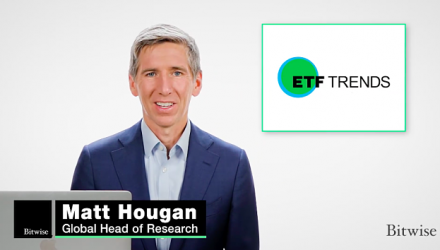Earlier this month on the ETF Trends hosted webcast, Bitcoin and the Coronavirus Crisis: Does Crypto Still Belong in Client Portfolios, Bitwise Asset Management received so many questions from advisors that they decided to film a follow-up video to answer the top five questions regarding the state of cryptocurrency.
Watch Matt Hougan, Global Head of Research for Bitwise, answer the questions in this video posted to YouTube:
Why not allocate 100% to Bitcoin?
As Hougan explains, there are practical and emotional reasons for this as to why most investors shouldn’t allocate more than 5% of their portfolio to Bitcoin. First, past performance is no guarantee of future returns. Bitcoin may have an excellent track record, but there’s no guarantee for where things are headed.
More practically, there’s another reason that focuses on rebalancing. It’s a concept referred to as volatility harvesting, which means if an investor has highly volatile, non-correlated assets like Bitcoin, they could improve their portfolios return by adding that asset to their portfolio, even if the asset never goes up. It works by using a disciplined rebalancing process. This can’t be achieved with a 90% or higher allocation, as there won’t enough to rebalance with.
The biggest reason, however, comes down to emotions and behavior. As Hougan explains, keeping an allocation at just 1-5% helps investors tolerate the ups and downs, keeping them with the programs. While some investors may want to go big, Bitcoin is a powerful portfolio stimulant, and even a small allocation can have a significant impact.
What is Matt’s personal allocation?
Hougan notes that he invests around 5% of his liquid net worth in crypto. He says he is currently a bit overweight, but he also has 90% of his portfolio invested in a robust, well-diversified portfolio, primarily built up of low-cost ETFs with a fixed-allocation that is rebalanced regularly.
Ten percent is reserved for what Hougan refers to as tactical investments. These are basically investments that he can focus on separately from the core portfolio, so there’s some form of control, however minor. So, in addition to having a stable set of allocations, he says he can experiment a bit in other areas, including Bitcoin.
What is Quantitative Easings impact on crypto going to be?
While it is very difficult to have an accurate read on how anything will play out currently, Hougan imagines three possible scenarios. In one version of events, QE is not enough, and the U.S. must enter a Japanese-style deflationary spiral, with years of zero interest rates and slow growth. Additionally, one could add in a worried generation hoarding its savings, which paints a fairly dismal picture.
Scenario two is similar to what took place in response to the 2008 financial crisis, when there was a massive amount of QE, largely offset by a drop in natural economic activity. Most of the consequences of that QE were kicked down the road.
For scenario three, Hougan explains how it would be what Ray Dalio and others are forecasting – massive debt monetization, currency debasement, and a possible toppling of the dollar as the world’s reserve currency. This would be the best scenario for crypto, where Bitcoin would then become the best investment in the world.
However, scenario two would be great for crypto as well. Removing the crisis and the QE, before the Coronavirus, crypto has a lot of secular trends pushing it from the back. Young investors are inclined to invest here, and crypto regulation and market infrastructure is improving.
What should I sell to fund my crypto allocation?
Hougan believes most investors will draw from one of two places. A lot of investors will draw from the equity side of their portfolio. It makes sense, as Bitcoin is a volatile asset, so it makes to sell another volatile asset to fund that purchase.
Other investors have a specific alternative sleeve in their portfolio, and Bitcoin fits very well there. So these investors may sell some of their gold, some of their commodities, a portion of their hedge fund positions, and use that money to direct it into Bitcoin.
Is crypto looking more like currency or digital gold?
To answer this, Hougan refers to the Lightning Network, a software program that aims to make the Bitcoin network exponentially faster. It’s an exciting technology that Hougan believes in, but regardless, there will be some kind of software that will keep Bitcoin from dying like some transactional currency.
However, even if Bitcoin can reach a higher speed than Visa, Hougan still believes its primary use will be as a non-sovereign store of wealth. As the U.S. is not at a point where Bitcoin is needed as a transactional currency, it is at a point where a way to store value outside of the infinitely QE’d greenback will be necessary.
The digital gold market is large enough to support a Bitcoin price that is ten to a hundred times higher than it is today. If it turns out that Bitcoin transforms into a useful everyday currency, then that’s all the better.
Watch Matt Hougan Explain Each Crypto Response Here:
For more market trends, visit ETF Trends.
The opinions and forecasts expressed herein are solely those of Tom Lydon, and may not actually come to pass. Information on this site should not be used or construed as an offer to sell, a solicitation of an offer to buy, or a recommendation for any product.
